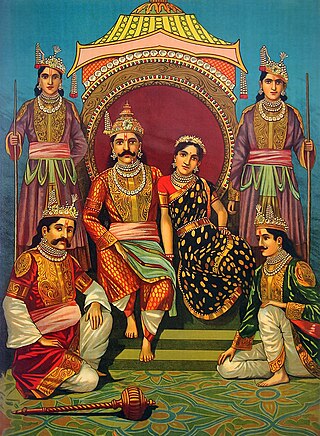
The Pandavas is a group name referring to the five legendary brothers, Yudhishtira, Bhima, Arjuna, Nakula, and Sahadeva, who are central figures of the Hindu epic Mahabharata. They are acknowledged as the sons of Pandu, the King of Kuru, but were fathered by different Devas (gods) due to Pandu's cursed inability to naturally conceive children. In the epic, the Pandavas married Draupadi, the princess of Panchala, and founded the city of Indraprastha after the Kuru Kingdom was split to avoid succession disputes. After the split, the other part of the kingdom was ruled by their cousins, the Kauravas. However, the Pandavas lost their kingdom to Duryodhana when Yudhishtira gambled it away during a game of dice. The bet Yudhishtira agreed to was that the Pandavas would hand the kingdom to the Kauravas and go into exile for 13 years. After this time the Kauravas refused to return the kingdom. As a result, the Pandavas waged a civil war against their extended family, and this conflict was known as the Kurukshetra War. With the help of the god Krishna, the Pandavas eventually won the war with the death of the Kauravas, albeit at great cost.
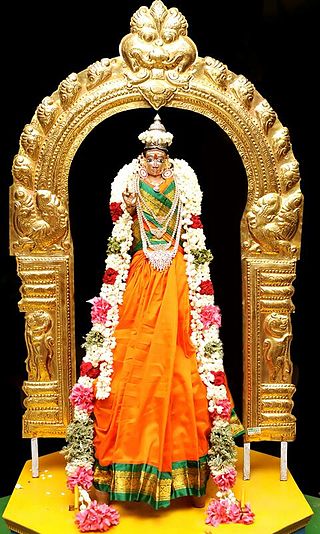
Draupadi, also referred to as Krishnā, Panchali, and Yajnaseni, is the main female protagonist of the ancient Indian epic Mahabharata, and the wife of the five Pandava brothers—Yudhishthira, Bhima, Arjuna, Nakula, and Sahadeva. She is noted for her beauty, courage and polyandrous marriage.
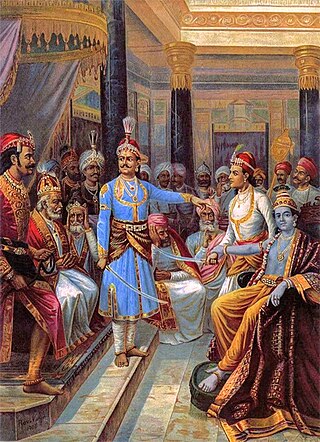
Duryodhana, also known as Suyodhana, is the primary antagonist in the Hindu epic Mahabharata. He was the eldest of the Kauravas, the hundred sons of the king Dhritarashtra and his queen Gandhari.

Yudhishthira also known as Dharmaraja, was the king of Indraprastha and later the King of Kuru Kingdom in the epic Mahabharata. He is the eldest among the five Pandavas, and is also one of the central characters of the epic.

Sahadeva was the youngest of the five Pandava brothers in the ancient Indian epic, the Mahabharata. He and his twin brother Nakula were the sons of Madri, one of the wives of the Pandava patriarch Pandu, and Ashvini Kumaras, the divine twin physicians of the gods, whom she invoked to beget her sons due to Pandu's inability to progenate. Kunti, Sahadeva's step-mother, loved him the most despite his birth to Madri. Sahadeva is renowned for his wisdom, knowledge of astrology, and skill in swordsmanship.
Gandiva is a divine bow of Arjuna, one of the Pandavas from the Hindu epic Mahabharata. The bow was made by Brahma.
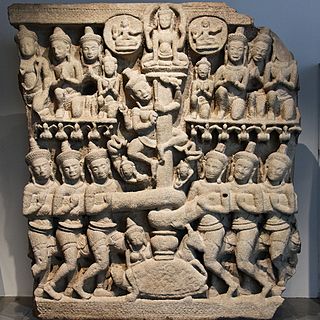
Hindu mythological wars are the wars described in the Hindu texts of ancient India. These wars depicted both mortals of great prowess as well as deities and supernatural beings, often wielding supernatural weapons of great power. Hindu teachings prescribe war as the final option, to be employed only after all peaceful methods are exhausted. Participation in righteous war, or dharmayuddha, was said to be honourable and was a principal duty of the Kshatriya or the warrior varna, and victory in such wars was regarded as a matter of honour.
Maya or Mayāsura (मयासुर) is a figure in Hindu mythology, described as the king of the Danavas, a race of beings descending from Kashyapa and his wife Danu. He is known for his architectural expertise, credited with creating the Mayasabha for the Pandavas and Tripura for the sons of Tarakasura. In the Ramayana, he is mentioned as the father-in-law of Ravana.

Jayadratha is the king of the Sindhu kingdom featured in the Mahabharata. He was married to Dushala, the only sister of the hundred Kaurava brothers. The son of the king Vriddhakshatra, he is killed by Arjuna. He has a son named Suratha.
The Karusha kingdom is one of the Yadava kingdoms of the Mahabharata epic. It is placed to the south of Chedi. Karusha king Dantavakra supported Chedi king Shishupala and was killed by Vasudeva Krishna. Karusha Kingdom is identified as modern Datia district of Madhya Pradesh.

Mahabharat is an Indian Hindi-language epic television series based on the ancient Sanskrit epic Mahabharata. The original airing consisted of a total of 94 episodes and were broadcast from 2 October 1988 to 24 June 1990 on Doordarshan. It was produced by B. R. Chopra and directed by his son, Ravi Chopra. The music was composed by Raj Kamal. The script was written by Pandit Narendra Sharma and the Hindi/Urdu poet Rahi Masoom Raza, based on the epic by Vyasa. Costumes for the series were provided by Maganlal Dresswala. The serial claims to have used the Critical Edition of Bhandarkar Oriental Research Institute as its basic source with Vishnu Sitaram Sukthankar and Shripad Krishna Belwalkar as its primary editor.

In Hindu mythology, the danavas are a race descending from Kashyapa and his wife Danu, a daughter of the progenitor god, Daksha. It is mentioned that there are one hundred danavas.

The Khandava Forest or Khandava Vana or Khandavaprastha is a forest mentioned in the epic Mahābhārata. It lay to the west of Yamuna river. The Pandavas are described to have cleared this forest to construct their capital city called Indraprastha. This forest was earlier inhabited by Nāgas led by a king named Takṣaka.

Sabha Parva, also called the "Book of the Assembly Hall", is the second of eighteen books of Mahabharata. Sabha Parva traditionally has 10 parts and 81 chapters. The critical edition of Sabha Parva has 9 parts and 72 chapters.
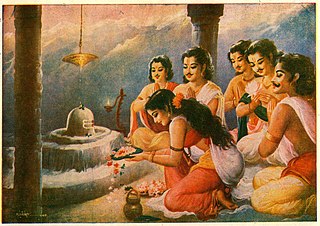
The Vana Parva, also known as the "Book of the Forest", is the third of eighteen parvas in the Indian epic Mahabharata. Vana Parva traditionally has 21 parts and 324 chapters. The critical edition of Vana Parva is the longest of the 18 books in the epic, containing 16 parts and 299 chapters.

The Bhishma Parva, or the Book of Bhishma, is the sixth of eighteen books of the Indian epic Mahabharata. It has 4 sub-books and 124 chapters.

The Drona Parva, or the Book of Drona, is the seventh of eighteen books of the Indian epic Mahabharata. Drona Parva traditionally has 8 parts and 204 chapters. The critical edition of Drona Parva has 8 parts and 173 chapters.

Mahaprasthanika Parva, or the "Book of the Great Journey", is the seventeenth of eighteen books of the Indian epic Mahabharata. It traditionally has three chapters, as does the critical edition. It is the shortest book in the epic.
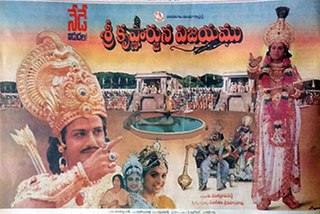
Sri Krishnarjuna Vijayam is a 1996 Indian Telugu-language Hindu mythological film, produced by B. Venkatarama Reddy under the Chandamama Vijaya Combines banner and directed by Singeetam Srinivasa Rao. It stars Nandamuri Balakrishna, Roja with music composed by Madhavapeddi Suresh. The film won four Nandi Awards. However, it was a box-office failure.

















